ADATA recently added to their 3D NAND SSD line with the SU900, a larger capacity option (2TB) that also includes performance improvements. Other than the newly added high speed SMI controller and the aforementioned changes, the SU900 is almost identical to its predecessor (the ADATA SU800 SSD). That said, the SU900 is being marketed as a good option for casual users looking to upgrade the storage of their ultrabooks, notebooks, or game consoles.
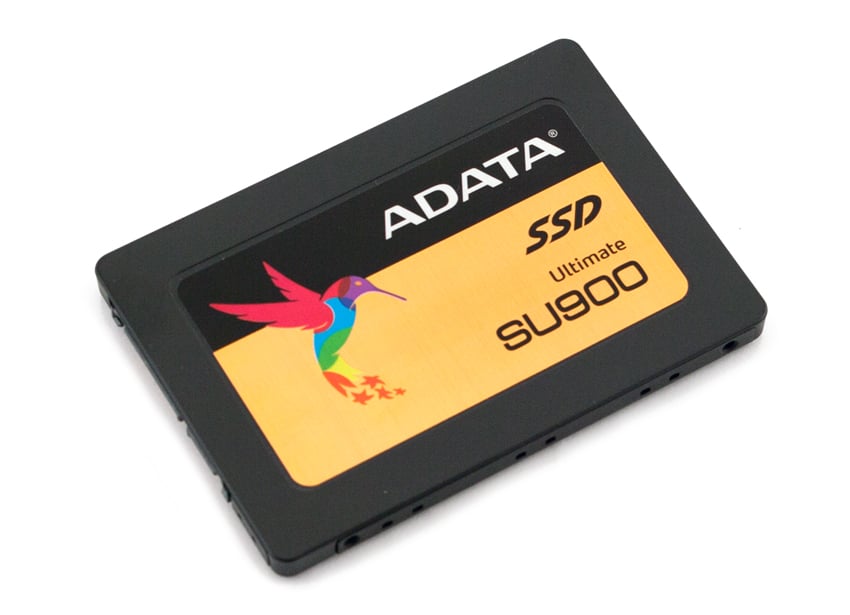
ADATA reports sequential transfer speeds of 560MB/s read and 525MB/s write, which is certainly in the ballpark for their intended users in terms of performance. The SU900 also comes with strong endurance and MTBF ratings (not to mention a 5-year warranty), which is probably even more important than performance with this class of SSD; users in the market for a mid-level notebook upgrade are less likely to nitpick about performance and more likely to choose an option that will last. The SU900 also comes with various data protection features (e.g., software/hardware write protection, early weak block retirement) that work to prevent drive failure and extend the life of the SSD during use.
The ADATA SU900 is now available in the 256GB, 512GB, and 1TB models for $100, $198, and $412, respectively. The 2TB model is not yet shipping at the time of writing.
Specifications
- Capacity
- 256GB (ASU900SS-256GM-C)
- 512GB (ASU900SS-512GM-C)
- 1TB (ASU900SS-1TM-C)
- 2TB (ASU900SS-2TM-C)
- Form Factor: 2.5″
- NAND Flash: 3D MLC
- Controller: SMI 2258
- Dimensions (L x W x H): 100.45mm x 69.85mm x 7mm
- Weight: 47.5g
- Interface: SATA 6Gb/s
- Sequential Performance (read and write): 560MB/s and 525MB/s
- Operating Temperature: 0ºC to 70ºC
- Storage Temperature: -40ºC to 85ºC
- Shock Resistance: 1500G/0.5ms
- MTBF: 2,000,000 hours
- Warranty: 5 years
Design and Build
The ADATA SU900 has the same look and feel as the SU800, except that it has a yellow sticker instead of blue. The card comes in a black case with additional information on the back (i.e., model number, warranty code).
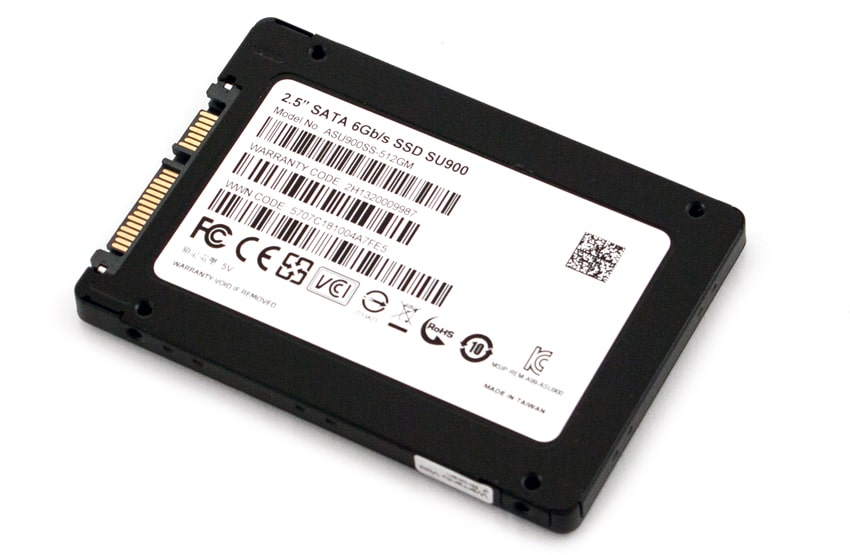
Popping off the cover revels the short PCB inside. The top side has four NAND packs covered by an ADATA sticker.
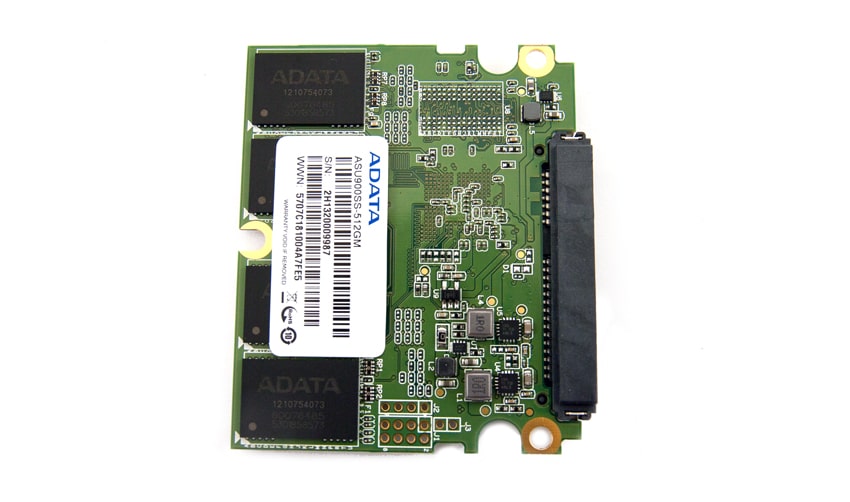
The other side of the PCB has four more NAND packs the DRAM and an SMI controller.
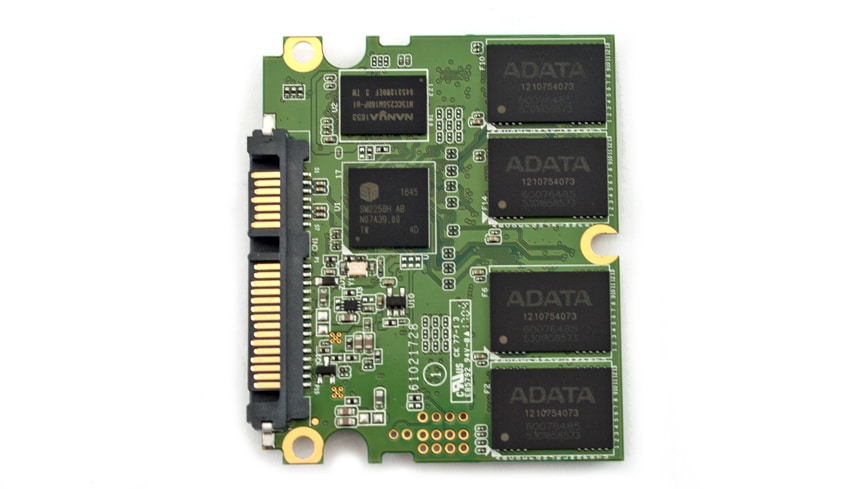
Consumer Synthetic Benchmarks
All consumer SSD benchmarks are conducted using the StorageReview HP Z640 Workstation. We compared the ADATA SU900 SSD to the following drives:
- Samsung 850 Pro SSD (1TB)
- Samsung 850 Pro SSD (2TB)
- Sandisk Extreme Pro SSD (960GB)
- Crucial MX200 SSD (500GB)
- Crucial MX200 SSD (1TB)
- Micron M600 SSD (1TB)
- OCZ VX500 SSD (512GB)
- WD Blue SSD (1TB)
All IOMeter figures are represented as binary figures for MB/s speeds.
In our 2MB sequential benchmark, the ADATA SU900 outperformed every other SSD in both read and write, posting 521.6MB/s and 472.6MB/s, respectively.
Although the ADATA SU900 fell behind somewhat in terms of read transfer speeds, it remained the top-performing drive in terms of 2MB random write with 473.38MB/s.
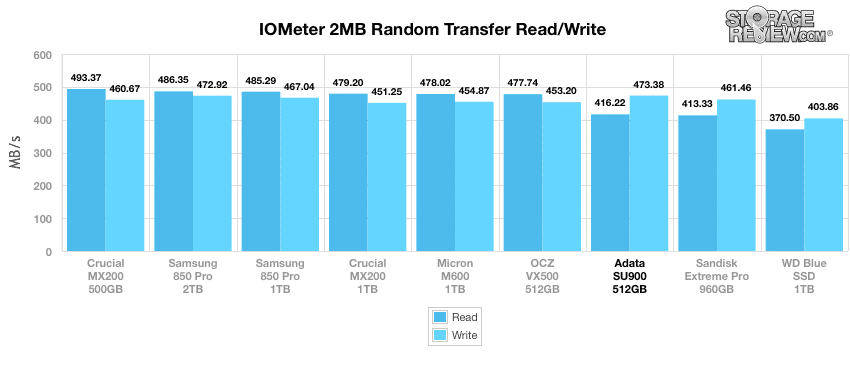
The purpose of our random 4k benchmark is to put more strain on the drives in terms of throughput. Under these conditions, the ADATA SU900 lagged behind the other drives, only posting 28.3MB/s and 106.0MB/s in read and write, respectively. This puts the SU900 behind all but one SSD (OCZ VX500 with 19.5MB/s and 102.4MB/s, respectively) for this benchmark.
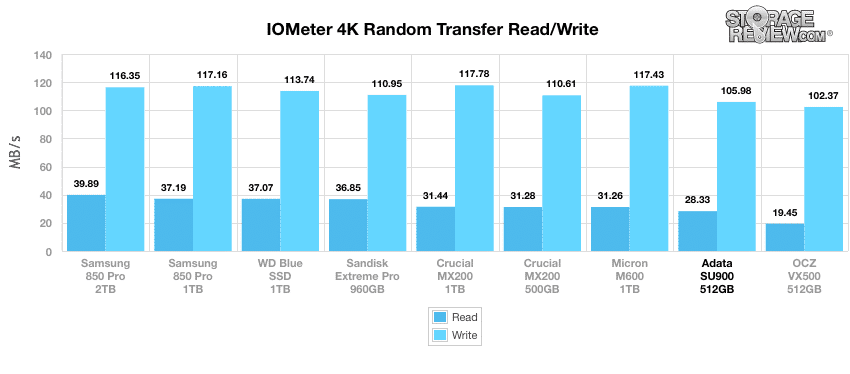
We found the same standings in terms of I/O per second, with the ADATA SU900 posting 7,251IOPS and 27,131IOPS in read and write, respectively.
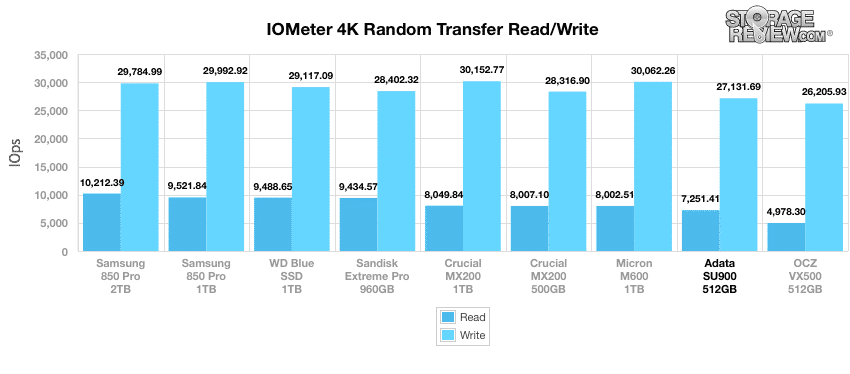
The ADATA SU900 was expectedly slow relative to the other drives in our 4k write latency benchmark, yielding an average latency of 0.367ms. The lowest average latency in this test was from the Crucial MX200 (1TB), which posted 0.0329ms. The ADATA SU900 was the weakest drive tested in terms of max latency (18.64ms), almost doubling the latency of its closest competitor (Samsung 850 Pro (2TB) with 10.07ms). For comparison, the top performer (the Samsung 850 Pro (1TB)) posted a max latency of 0.18ms.
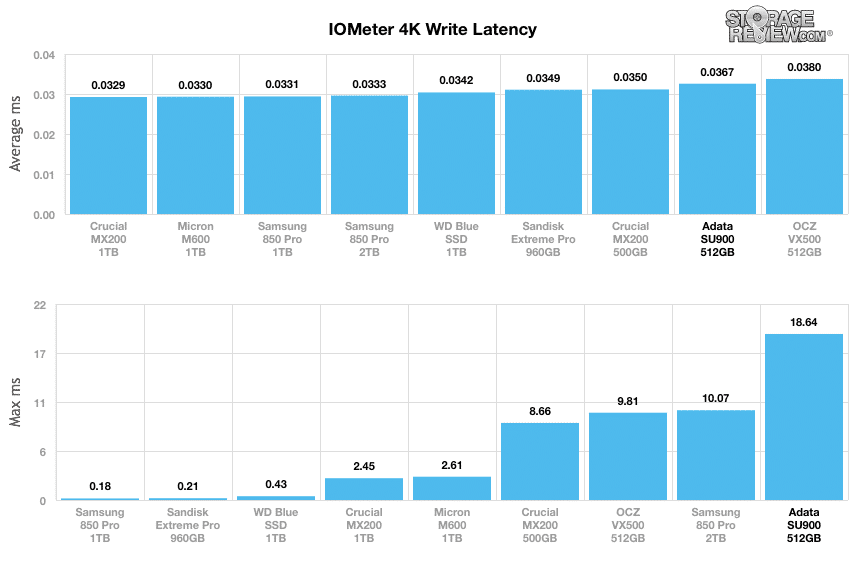
For our next 4K test, we move to a workload with 100% write activity, which scales from 1QD to 64QD. The ADATA SU900 performed fairly well in the aligned write portion of this test, although there were several SSDs that yielded stronger results. The SU900 outperformed the WD Blue (1TB) and the OCZ VX500 (512GB).
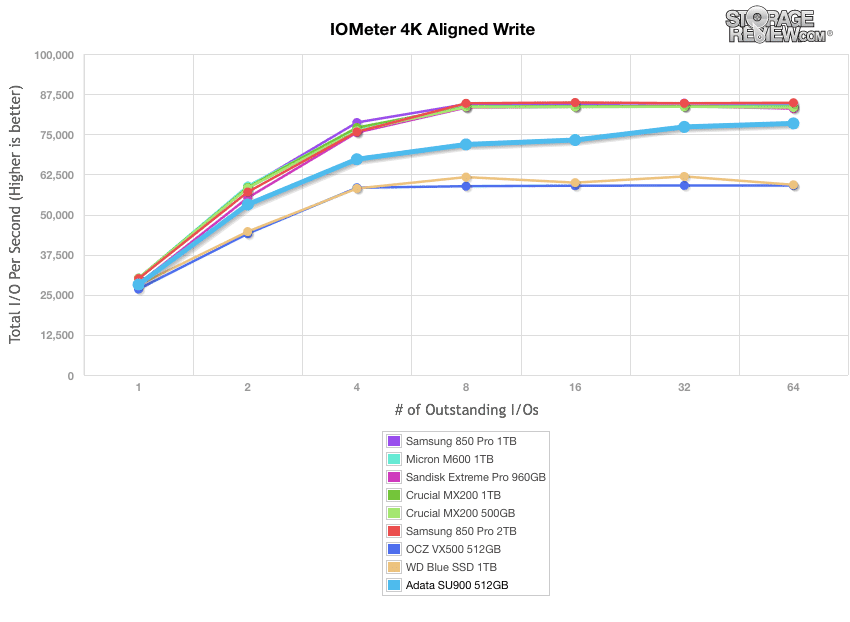
We saw a drop in performance for the ADATA SU900 when we switched to the aligned read portion of this benchmark, which put it in last place overall. The OCZ VX500 started out with fewer IOPS than the SU900, but by the end of the test the SU900 dropped to the bottom of the pack.
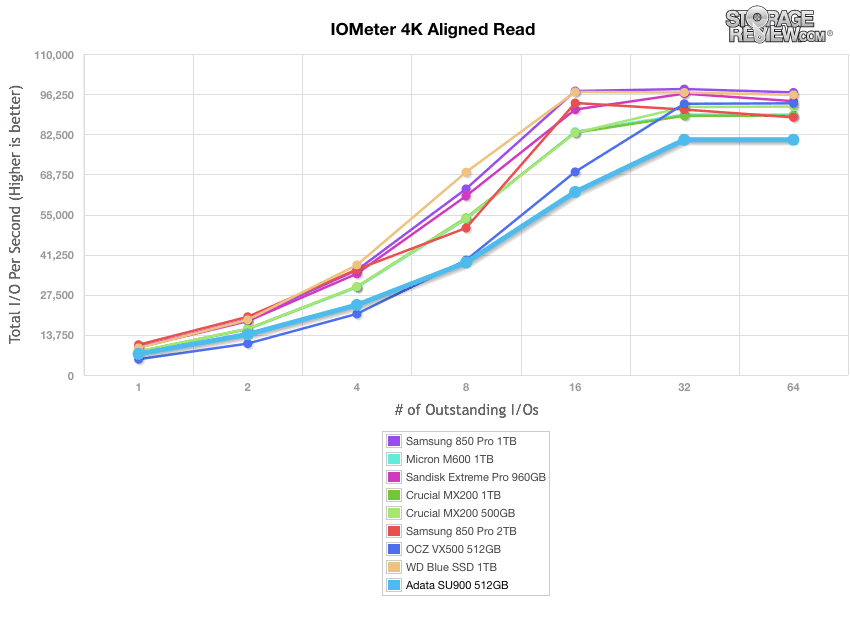
Our final consumer-synthetic benchmarks compare the drives in a series of mixed-server workloads with a queue depth of 1 to 128. Each server profile has a strong bias towards read activity, ranging from 67% read with the database profile to 100% read in the web server profile.
The database profile features a 67% read and 33% write workload, focusing on transfers around 8K in size. Although the ADATA SU900 was neck and neck with the Sandisk Extreme Pro for most of the database profile, by the end of the test the SU900 fell to the bottom of the pack.
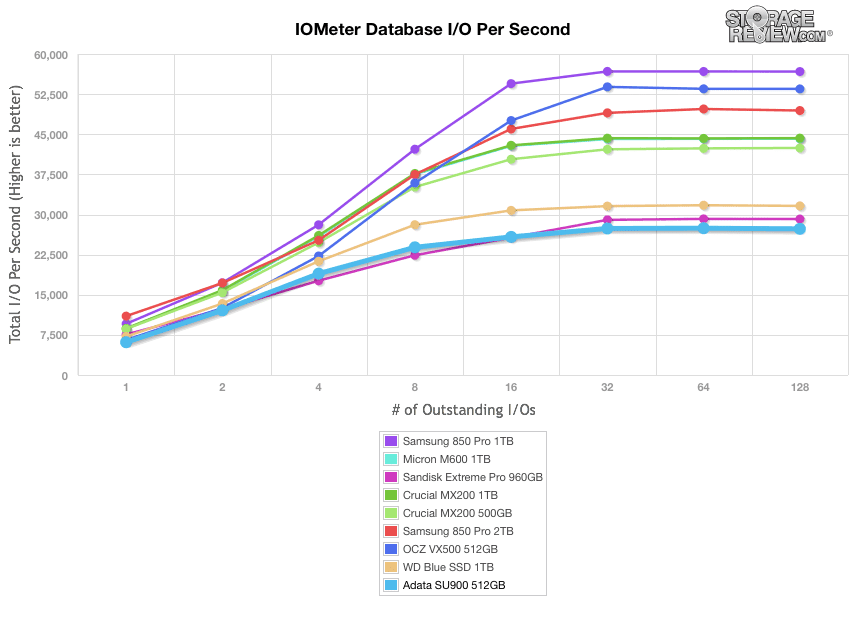
Our next benchmark is the read-only web-server profile, which uses transfer sizes ranging from 512 bytes to 512KB. In this installment of our consumer-synthetic benchmarks, the ADATA SU900 remained well-established as the weakest drive through the duration of the test. The SU900’s closest competitor was the WD Blue SSD.
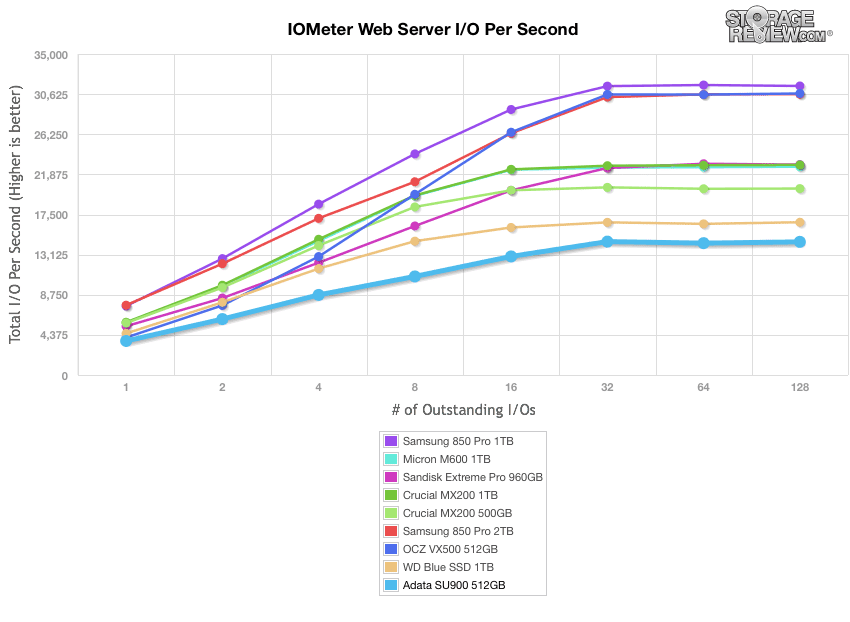
Our file-server profile has 80% read and 20% write workload and is spread out over multiple transfer sizes ranging from 512-bytes to 64KB. Although it started out as one of the weaker SSDs, the ADATA SU900 finished out this test as one of the top drives, trailing behind only two others (the OCZ VX500 and the Samsung 850 Pro (2TB)).
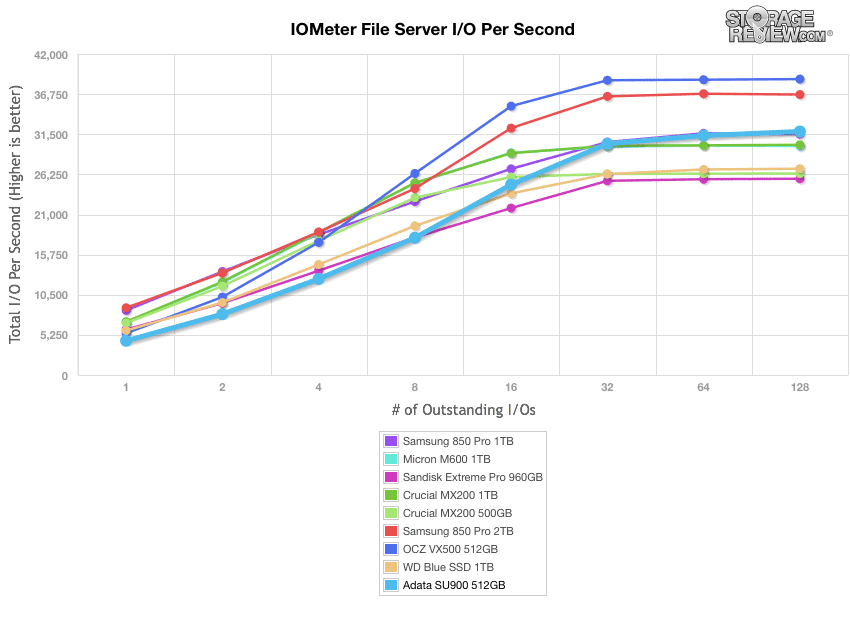
The last profile looks at workstation activity; with a 20% write and 80% read mixture using 8K transfers. The ADATA SU900 reclaimed its standing as the weakest SSD in the final consumer-synthetic benchmark, with an unusual performance trajectory that reflects its strained performance.
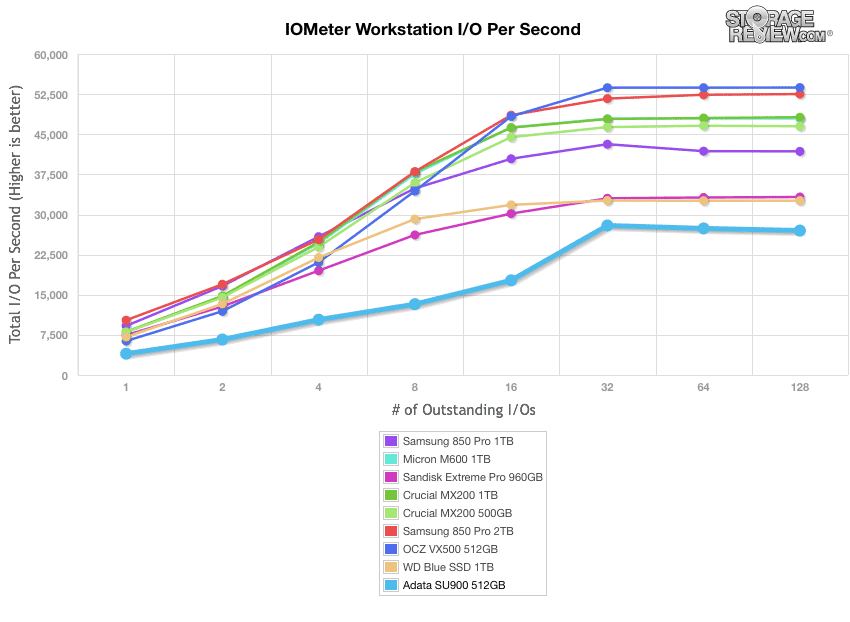
Consumer Real-World Benchmarks
While the results of synthetic benchmarks are important in identifying the key strengths and weaknesses of a drive, performance in these tests does not always translate directly into real-world situations. To get a better idea how the ADATA SU900 SSD will handle itself in the field, we will chart StorageMark 2010 HTPC, Productivity, and Gaming traces against comparable drives. Higher IOPS and MB/s rates with lower latency times are preferred.
The first trace is based on use as a Home Theater PC (HTPC). The test includes playing one 720P HD movie in Media Player Classic, one 480P SD movie playing in VLC, three movies downloading simultaneously through iTunes, and one 1080i HDTV stream being recorded through Windows Media Center over a 15-minute period.
The ADATA SU900 exhibited an average performance in our HTPC benchmark, posting 333.0MB/s, 7,138IOPS, and an average latency of 1.028ms.
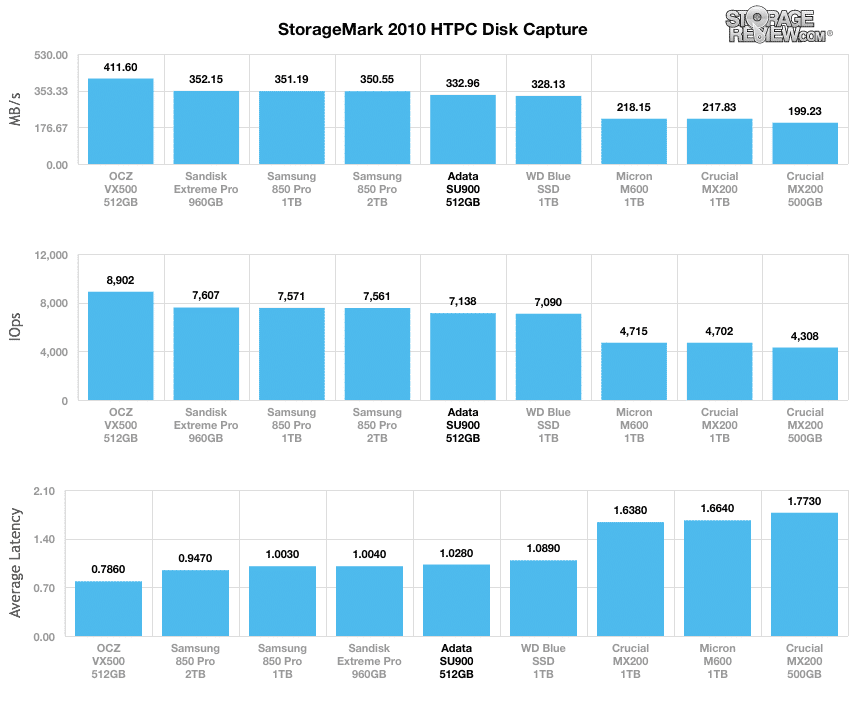
The next trace simulates disk activity in an office workstation or productivity scenario. This test includes three hours of operation in an office productivity environment with 32-bit Windows Vista running Outlook 2007 connected to an Exchange server, web browsing using Chrome and IE8, editing files within Office 2007, viewing PDFs in Adobe Reader, an hour of local music playback, and two hours of streaming music via Pandora.
We saw a slight improvement for the ADATA SU900 in our productivity disk capture, which yielded 282.4MB/s, 9,655IOPS, and an average latency of 0.783ms.
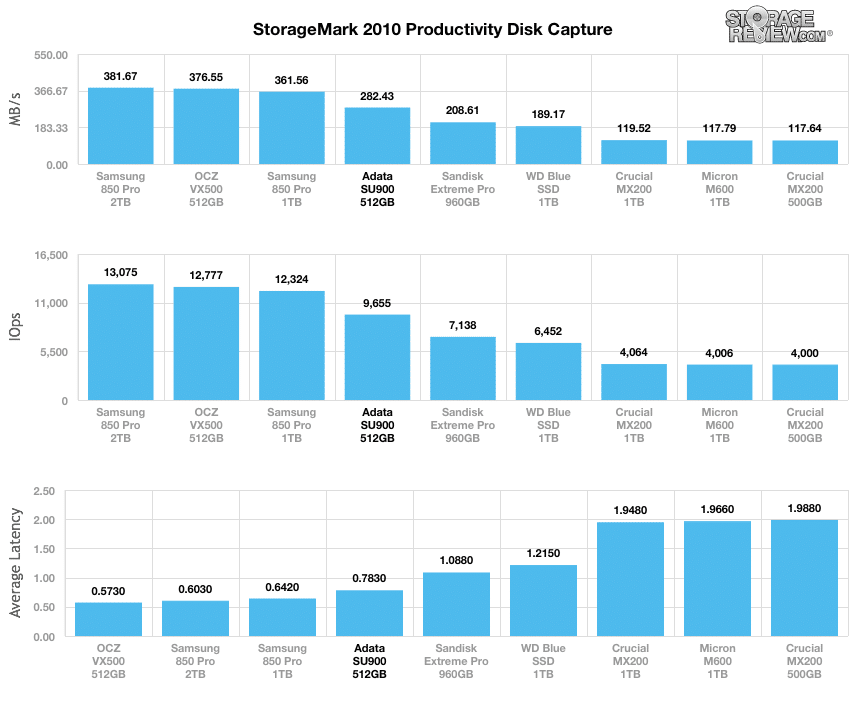
The final consumer real-life benchmark simulates disk activity during gaming. This simulation taxes the drive’s read performance, with 6% write operations and 94% read operations. The test consists of a Windows 7 Ultimate 64-bit system pre-configured with Steam, and with Grand Theft Auto 4, Left 4 Dead 2, and Mass Effect 2 already downloaded and installed. The trace captures the heavy read activity of each game loading from the start, as well as textures as the game progresses.
The ADATA SU900 fell behind somewhat in our final test, especially in terms of average latency (411.3MB/s, 7,793IOPS, and 1.003ms).
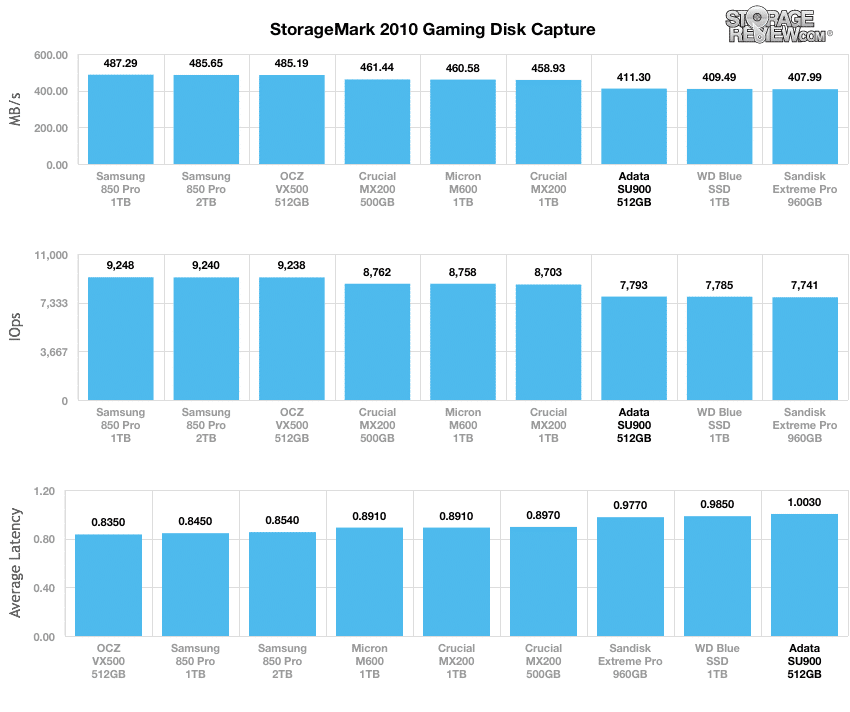
Conclusion
The SU900 provides up to 2TB of storage leveraging 3D MLC NAND. Aside from the capacity upgrade, ADATA also stated better performance for their new drive to make it an attractive upgrade option for notebooks. The drive starts as low as $100 for the smaller capacity model and offers several data protection features such as software/hardware write protection and early weak block retirement.
Looking at performance the drive turned in a mixed performance. The SU900 really shined in the 2MB IOMeter where it had the best sequential read and write scores of 521.55MB/s and 472.59MB/s, respectively and the best random write performance of 473.38MB/s. Its 4K IOMeter test put it right in the average scores in throughput and near the bottom of the pack in latency. Our consumer real-world benchmarks saw the SU900 coming in the middle to near the end of the pack with it having the highest latency in our gaming capture. For the value-based market though, these numbers are generally respectable.
Pros
- Great option for mid-level notebooks
- 5-year warranty
Cons
- Weak performance in many of our benchmarks
The Bottom Line
The ADATA SU900 SSD offers up to 2TB of storage and is perfect for notebook drive replacement, especially for users who prioritize price and reliability over performance.


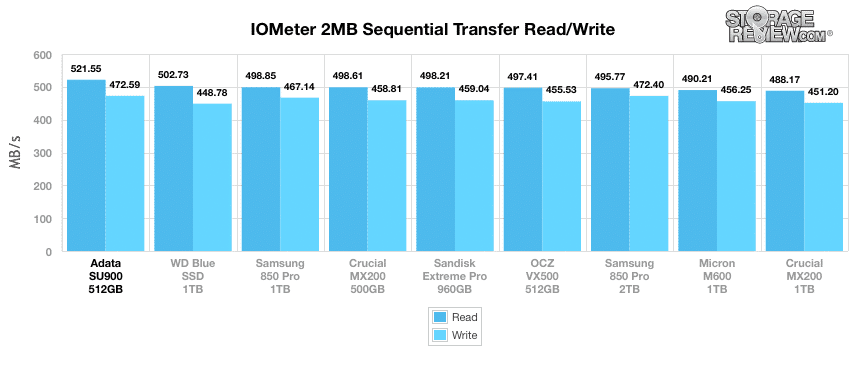


 Amazon
Amazon